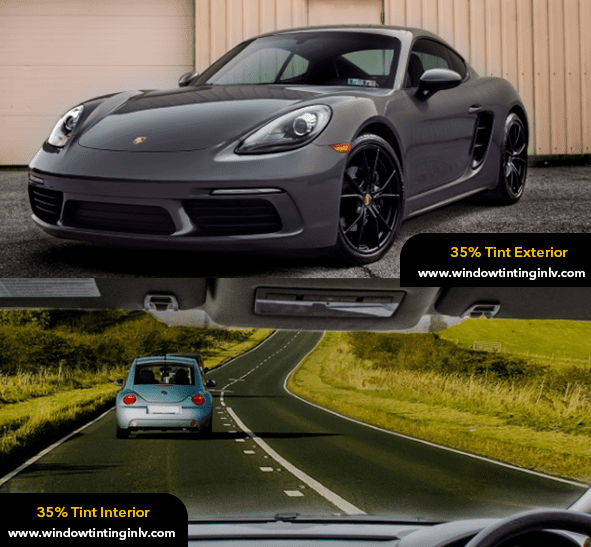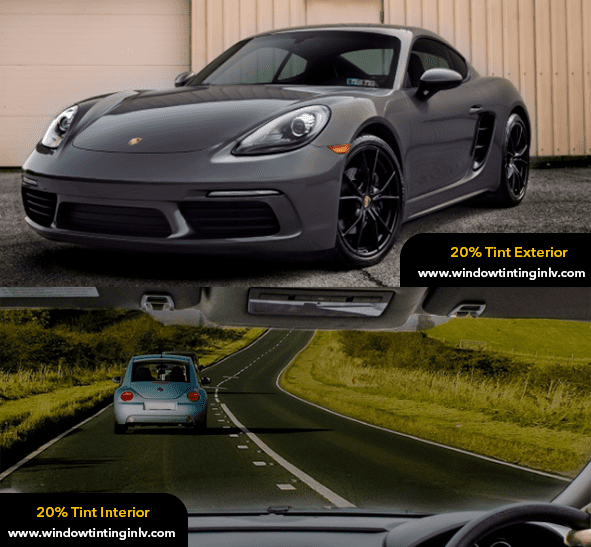Tinting your car windows offers a range of benefits, from keeping your interior cooler to reducing sun glare and enhancing privacy.
But when it comes to choosing the right tint of darkness, there’s a decision to be made: 35% or 20%?
This guide will delve into the key differences between these two popular tint options, helping you understand how they impact factors like light transmission, heat reduction, visibility, and legality.
We’ll explore the advantages and disadvantages of each tint level, allowing you to make an informed choice that best suits your driving needs and preferences.
Whether you prioritize maximizing heat rejection or maintaining clear visibility for safe nighttime driving, this guide will equip you with the knowledge to select the perfect tint for your car.
Light Transmission (VLT)
Understanding Visible Light Transmission (VLT) is crucial when choosing window tint. VLT refers to the percentage of visible light that passes through the film. The key takeaway is that a lower VLT percentage translates to a darker tint.
Here’s the breakdown:
35% Tint: This tint allows 35% of visible light to enter your car. It provides a noticeable darkening effect but still offers clarity, especially during the day. You can see out comfortably and maintain good visibility for driving.
20% Tint: This tint only allows 20% of visible light through. This creates a significantly darker appearance for your car’s windows, offering a near-blacked-out look from the outside. While it provides excellent privacy, night driving visibility can be considerably reduced.
Benefits
Both 35% and 20% tint offer advantages, but they cater to different priorities. Let’s explore the key benefits of each:
35% Tint:

Heat and Glare Reduction: It offers a moderate level of heat rejection, making your car noticeably cooler on sunny days.
Balanced Visibility: This tint strikes a good balance between privacy and maintaining clear visibility. You can see out comfortably while reducing the sun’s glare.
Night Driving Safety: Due to better outward visibility, 35% tint is generally considered safer for nighttime driving.
20% Tint:

Significant Heat Reduction: This tint significantly blocks heat from entering your car, making a substantial difference in hot climates.
Enhanced Glare Reduction: With less light coming through, 20% tint provides a superior level of glare reduction, improving driving comfort.
Increased Privacy: The dark film offers a high level of privacy, obscuring the view into your car for unwanted onlookers.
Visibility
While both tints offer sun protection, the level of darkness can significantly impact visibility, especially at night.
Here’s a breakdown of how visibility differs:
35% Tint: This tint allows for good outward visibility during the day and maintains a reasonable level of clarity at night. You can see pedestrians, cyclists, and oncoming traffic clearly, ensuring safer driving conditions.
20% Tint: Due to the considerably darker film, visibility, particularly at night, can be significantly reduced. Driving in low-light conditions might require more focus and caution to navigate safely. Reversing and parking manoeuvres might also be trickier due to limited visibility.
Legality
Window tint laws vary considerably by location. It’s crucial to check the legal limit for tint darkness in your area before getting your car windows tinted. Here’s why legality is important:
Compliance: Exceeding the legal tint limit can lead to fines and require you to remove the tint to comply with regulations.
Safety Concerns: Lawmakers establish tint restrictions partially for safety reasons. Excessive darkness can hinder driver visibility, potentially impacting road safety.
20% Tint Risks: While popular for its darkness, 20% tint might be illegal in many areas. Researching local tint laws beforehand can save you from potential hassles and ensure your car complies with regulations.
35 Tint vs 20 | Choosing Between Them
The ideal tint for your car depends on your priorities and driving habits. Here are some factors to consider when making your choice:
Climate: If you live in a hot and sunny climate, a 20% tint might be more appealing for heat reduction. However, 35% tint offers a good balance in moderate climates.
Night Driving: If you frequently drive at night, 35% tint is generally the safer option due to better visibility.
Local Tint Laws: Always check the legal limit for tint darkness in your area to avoid exceeding regulations.
Priorities: Consider what matters most to you. Do you prioritize heat reduction and privacy (20% tint), or do you value clear visibility, especially at night (35% tint)?
By understanding these factors and the pros and cons of each tint level, you can make an informed decision that best suits your needs and driving habits.
What People are Saying about 35% vs 20
“I always 35% tint mine. I like it because it light enough to allow the OEM auto tint the glass to darken the windows on sunny days, but not too dark that I have to put the window down at night to see out.”
Conclusion
In conclusion, both 35% and 20% window tint offer valuable benefits, but the ideal choice depends on your priorities.
If you live in a hot climate and prioritize heat reduction and privacy, 20% tint might be the way to go.
However, if you frequently drive at night or value clear visibility, 35% tint provides a safer and more practical option.
Remember to check your local tint laws before making a decision, and prioritize your driving habits and needs when selecting the best level of tint for your car.
With the knowledge provided in this guide, you can confidently choose the window tint that keeps your car cool, comfortable and enhances your driving experience.
Window Tint: 35% vs. 20% – Q&A
Q: Which is darker, 35% tint or 20% tint?
A: 20% tint is darker than 35% tint. In window tint, the lower the percentage, the less light it lets in, resulting in a darker appearance.
Q: Can you see out of 35% tint at night?
A: Yes, generally you can see out of 35% tint at night. Compared to darker tints, it provides a good balance between sun protection and maintaining visibility.
Q: Is 20% tint too dark?
A: It depends on your priorities and location. While 20% tint offers excellent heat rejection and privacy, it can significantly reduce visibility, especially at night. Additionally, some areas have laws restricting how dark your window tint can be.
Q: Is 20% tint legal?
A: Not necessarily. Window tint laws vary by location. Before getting your windows tinted, check the legal limit for tint darkness in your area.
Q: Should I get 35% or 20% tint?
A: The ideal choice depends on your needs. Consider factors like:
Climate: If it’s hot and sunny where you live, 20% tint might be more appealing for heat reduction.
Night driving: If you frequently drive at night, 35% tint is generally safer due to better visibility.
Local laws: Always check the legal limit for tint darkness in your area.
Priorities: Do you prioritize heat reduction and privacy (20% tint) or clear visibility, especially at night (35% tint)?
References
https://www.cadillacforums.com/threads/window-tint-35-or-20.499585/